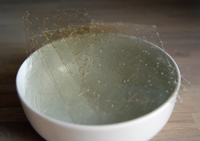
Photo from wikipedia
Gelatin extracted from chromium-tanned leather wastes (CTLW) has a lower molar mass because of the more aggressive extraction process needed to disrupt chromium-collagen bonds when compared to gelatin extracted from… Click to show full abstract
Gelatin extracted from chromium-tanned leather wastes (CTLW) has a lower molar mass because of the more aggressive extraction process needed to disrupt chromium-collagen bonds when compared to gelatin extracted from the bones, skin, and connective tissues of animals. As a consequence, CTLW gelatin is more hydrophilic, thus it is harder to apply in the production of polymers. To overcome this issue, in this study, films produced with starch, CTLW gelatin, commercial gelatin (as a comparative), and their blends were cross-linked with glutaraldehyde. The cross-linking reduced the crystallinity of the films, impairing the reorganization of gelatin chains into a triple helix structure, which balanced the effect of the higher molecular chain, while not altering the films’ tensile strength. It increased the elongation at break and reduced the solubility and the swelling degree by up to 53% and 69%, respectively. These results stand as a great advance for the practical use of starch-CTLW gelatin films.
Journal Title: Journal of Polymers and the Environment
Year Published: 2020
Link to full text (if available)
Share on Social Media: Sign Up to like & get
recommendations!